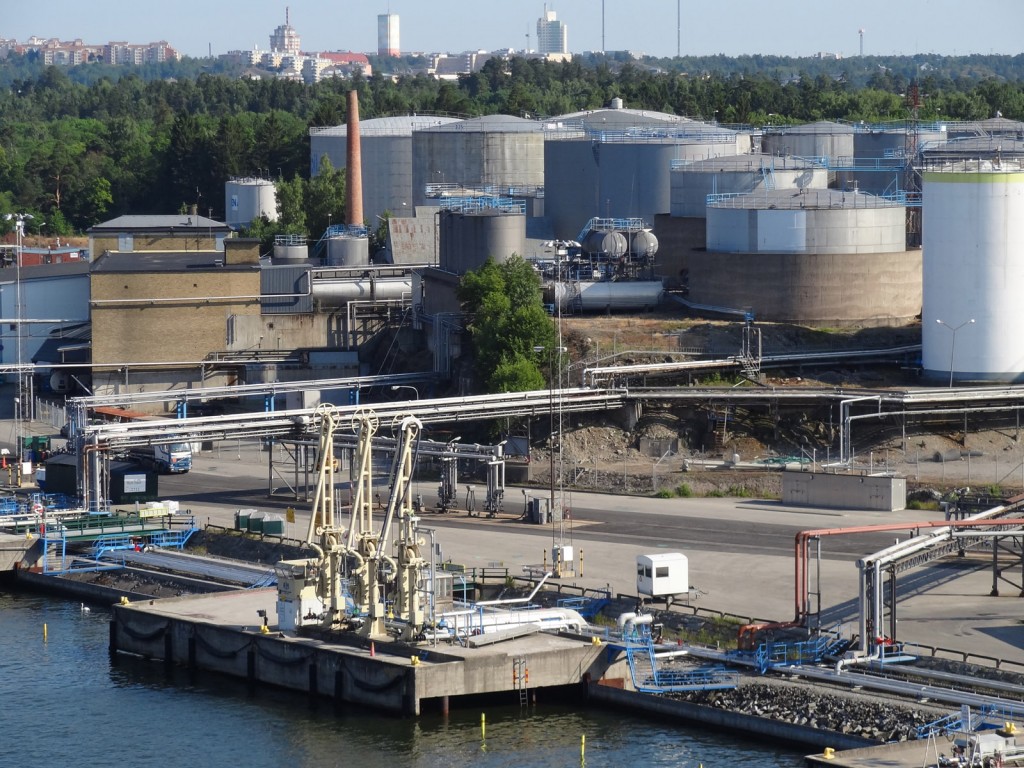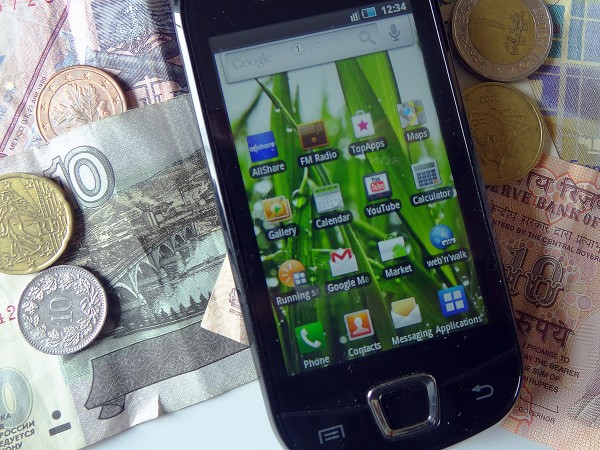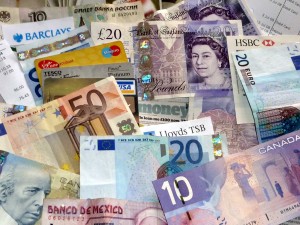 In the blog OPEC deal pushes up oil prices John discussed the agreement made by OPEC members to reduce total oil output from the start of 2017, with Saudi Arabia making the biggest cut in output. The amount of oil being provided is a key determinant of the oil price and this agreement to reduce oil output contributed to rising prices. However, now oil prices have begun to fall (see chart below) with Saudi Arabia in particular recording an increase in output but all OPEC nations noting that global crude stocks had risen.
In the blog OPEC deal pushes up oil prices John discussed the agreement made by OPEC members to reduce total oil output from the start of 2017, with Saudi Arabia making the biggest cut in output. The amount of oil being provided is a key determinant of the oil price and this agreement to reduce oil output contributed to rising prices. However, now oil prices have begun to fall (see chart below) with Saudi Arabia in particular recording an increase in output but all OPEC nations noting that global crude stocks had risen.
Supply and demand are key here and over the past few years, it has been a problem of excess supply that has led to low prices. OPEC nations have been aiming to achieve greater stability in global oil markets. Given the excess supply, it has been output of oil that the cartel member have been trying to cut. That was the point of the agreement that came into effect from the start of 2017. However, even with the recent increase in production Saudi Arabia notes that its output is still in line with its output target. The 10 percent fall in crude prices over such a short period of time has led to renewed concerns that pledges to reduce production will not be met. However Saudi Arabia’s energy ministry stated:
“Saudi Arabia assures the market that it is committed and determined to stabilising the global oil market by working closely with all other participating Opec and non-Opec producers.”
There were already concerns about the oil market relating to a potential increase in US shale oil output. Oil producers include OPEC and non-OPEC members and so while the cartel has agreed to cut production, it has little control over production from non-cartel members.  This was one of the main factors that contributed to the oil price lows that we previously saw. OPEC’s forecast for oil production from non-OPEC member has been raised for 2017 and overall production from all oil producing nations looks set to increase for the year, despite OPEC curbing output by 1.2 million barrels per day. However, despite the 10% drop, the price of crude oil ($50) still remains well above its low of $28 in January 2016.
This was one of the main factors that contributed to the oil price lows that we previously saw. OPEC’s forecast for oil production from non-OPEC member has been raised for 2017 and overall production from all oil producing nations looks set to increase for the year, despite OPEC curbing output by 1.2 million barrels per day. However, despite the 10% drop, the price of crude oil ($50) still remains well above its low of $28 in January 2016.
Oil prices are one of the key factors that affect inflation and with UK inflation expected to rise, this fall in oil prices may provide a small and temporary pause in the rise in the rate of inflation. There are many inter-related factors that affect oil prices and it really is a supply and demand market. If US shale oil production continues to rise, then total oil output will rise too and this will push down prices. If OPEC members undertake further production curbs, then this will push supply back down. Then we have demand to consider! Watch this space.
Report
OPEC Monthly Oil Market Report OPEC (14/3/17)
Articles
Saudis stand by commitment to oil production cuts Financial Times, Anjli Raval and David Sheppard (15/3/17)
Oil prices fall after Opec stocks rise BBC News (14/3/17)
Crude oil price slumps to new three-month low after OPEC supply warning Independent, Alex Lawler (14/3/17)
Opinion: Saudi Arabis has a big motivating interest in keeping oil prices high MarketWatch, Thomas H Kee Jr. (14/3/17)
Why oil prices may come under even more pressure next month Investor’s Business Daily, Gillian Rich (13/3/17)
Oil price crashes back towards $50 as Opec raises US oil forecasts The Telegraph, Jillian Ambrose (14/3/17)
Data and Information
Brent Crude Prices Daily US Energy Information Administration
OPEC Homepage Organisation of the Petroleum Exporting Countries
Questions
- What are the demand and supply-side factors that affect oil prices? Do you think demand and supply are relatively elastic or inelastic? Explain your answer.
- Use a demand and supply diagram to illustrate how OPEC production curbs will affect oil prices.
- If we now take into account US shale production rising, how will this affect oil prices?
- Why have OPEC members agreed to curb oil production? Is it a rational decision?
- What are the key points from the oil market report?
- How do oil prices affect a country’s rate of inflation?
- What, do you think, are oil prices likely to be at the end of the year? What about in ten years? Explain your answer.
- Should the USA continue to invest in new shale oil production?
 Market trading has existed for centuries and in many respects it hasn’t changed very much. One thing that has developed is the means of exchange. Goods used to be traded for other goods – for example 1 pig for 4 chickens! But then money was developed as a means of exchange and then came cheques and plastic.
Market trading has existed for centuries and in many respects it hasn’t changed very much. One thing that has developed is the means of exchange. Goods used to be traded for other goods – for example 1 pig for 4 chickens! But then money was developed as a means of exchange and then came cheques and plastic.
However, for many market traders, accepting credit and debit cards is relatively costly. It involves paying a monthly contract, which for many traders is simply not worthwhile, based on the quantity and value of the transactions. But, for many customers using debit or credit cards is the preferred method of payment and the fact that some traders only accept cash can be a deterrent to them making purchases and this therefore reduces the sales of the market traders.
 But, with advances in technology a new way of paying has emerged. Small card readers can now be plugged into iphones, ipads, other tablets and smartphones. By putting a customer’s card into this device customers can then pay by card and either sign for their purchase or use the phone to enter their security details. There are plan for these companies to offer chip and pin technology to further ease payment by card on market stalls. The traders pay a small commission per transaction, but aside from that, the initial start-up cost is minimal and it is likely to encourage more customers to use markets. Jim Stewart, the Director of a firm that has begun using this technology said:
But, with advances in technology a new way of paying has emerged. Small card readers can now be plugged into iphones, ipads, other tablets and smartphones. By putting a customer’s card into this device customers can then pay by card and either sign for their purchase or use the phone to enter their security details. There are plan for these companies to offer chip and pin technology to further ease payment by card on market stalls. The traders pay a small commission per transaction, but aside from that, the initial start-up cost is minimal and it is likely to encourage more customers to use markets. Jim Stewart, the Director of a firm that has begun using this technology said:
I think it’s definitely going to take off, the world is going that way … The money has always appeared in my bank account, no transactions have been declined, my accountant is happy, it’s all been good.
Some customers have raised concerns about the security of these transactions, as they have to put their cards into someone else’s ipad. However, traders have said that there are no risks and that customers can be sent a receipt for their purchase. The following few articles look at this latest (and other) technological developments.
Smartphone card payment system seeks small firms BBC News, Rob Howard (19/1/13)
POS Trends: What’s new for 2013 Resource News (17/1/13)
Payments by text message service to launch in UK in Spring 2014 BBC News (15/1/13)
Questions
- What are fixed cost and why does having a traditional card payment machine represent a fixed cost for a firm?
- How might this new technology affect a firm’s sales and profits?
- Will there be an increase in the firm’s variable costs from adopting this technology?
- Using a cost and revenue diagram, put your answers to questions 1 – 3 into practice and show how it will shift them and thus how the equilibrium may change for a market trader.
- What are the properties of money that allow it to be a good medium of exchange?
- How will this increased use of debit and credit cards affect the demand for money? Use a diagram to illustrate your answer.
 Between December 2007 and March 2009, the Bank of England reduced Bank Rate on several occasions in order to stimulate the economy and combat recession. By March 2009, the rate stood at a record low of 0.5%. Each month the Monetary Policy Committee meets to decide on interest rates and since March 2009, the members’ decision has consistently been that Bank Rate needs to remain at 0.5%.
Between December 2007 and March 2009, the Bank of England reduced Bank Rate on several occasions in order to stimulate the economy and combat recession. By March 2009, the rate stood at a record low of 0.5%. Each month the Monetary Policy Committee meets to decide on interest rates and since March 2009, the members’ decision has consistently been that Bank Rate needs to remain at 0.5%.
Although the UK economy has been making tentative steps towards recovery, it is still in a very vulnerable state. Last month, the Bank of England extended its programme of quantitative easing to a total £325bn stimulus. This, together with the decision to keep interest rates down and with the shock fall in manufacturing output contributing towards first quarter growth of just 0.1%, is a key indication that the UK economy is still struggling, even though the central bank thinks it unlikely that the UK will re-enter recession this year.
Monetary policy in the UK has been very much geared towards stimulating economic growth, despite interest rates typically being the main tool to keep inflation on target at 2%. The problem facing the central bank is that economic growth and inflation are in something of a conflict. Low interest rates to stimulate economic growth also create a higher inflation environment and that is the trade-off the economy has faced. Inflation has been well above its target for some months (a high of 5.2% in September 2011), and the low interest rate environment has done little to deflate the figure. After all, low interest rates are a monetary instrument that can be used to boost aggregate demand, which can then create demand-pull inflation. However, inflation is now slowly beginning to fall, but this downward trend could be reversed with the sky high oil prices we are recently experiencing. If inflation does begin to creep back up, the Monetary Policy Committee will once again face a decision: keep Bank Rate low and continue with quantitative easing to stimulate the economy or increase Bank Rate to counter the higher rate of inflation.
The data over recent months has been truly inconsistent. Some indicators suggest improvements in the economy and the financial environment, whereas others indicate an economic situation that is moving very quickly in the wrong direction. A key factor is that the direction the UK economy takes is very much dependent on the world economy and, in particular, on how events in the eurozone unfold. The following articles consider some of the latest economic developments.
UK economy grew 0.1% to avoid recession, says NIESR Guardian, Katie Allen (5/4/12)
UK interest rates held at 0.5% BBC News (5/4/12)
UK just about avoided recession in Q1, NIESR says Telegraph, Angela Monaghan (5/4/12)
Bank of England keeps interest rates on hold at 0.5pc Telegraph (5/4/12)
UK economy ‘weak but showing signs of improvement’ BBC News (3/4/12)
Bank of England holds on quantitative easing and interest rates Guardian, Katie Allen (5/4/12)
Faith on Tories on economy hits new low Financial Times, Helen Warrell (6/4/12)
Questions
- Which factors will the Monetary Policy Committee consider when setting interest rates?
- Using a diagram to help your answer, illustrate and explain the trade-off that the MPC faces when choosing to keep interest rates low or raise them.
- What is quantitative easing? How is it expected to boost economic growth in the UK?
- Which factors are likely to have contributed towards the low growth rate the UK economy experienced in the first quarter of 2012?
- Explain the trends that we have seen in UK inflation over the past year. What factors have caused the figure to increase to a high in September and then fall back down?
- What do you expect to happen to inflation over the next few months? To what extent is your answer dependent on the MPC’s interest rate decisions?
- Although the official figures suggest that the UK avoided a double-dip recession, do you agree with this assessment? Explain your answer.
GDP (or Gross Domestic Product) measures the value of output produced within a country over a 12-month period. It is this figure which we use to see how much the economy is growing (or shrinking). We can also look at how much different sectors contribute towards this figure. Over the past few decades, there has been a significant change in the output of different sectors, as a percentage of GDP, within the UK economy. In particular, the contribution of manufacturing has diminished, while services have grown rapidly.
However, there is one specific area that is making a growing contribution towards UK GDP and is expected to see acceleration in its growth rate by some 10% annually over the next few years: the internet. Although the internet is not an economic sector, the Boston Consulting Group (BCG) said that if it was, it would be the UK’s fifth largest sector and according to a report by Google, it is worth approximately £100 billion per year to the UK economy. Furthermore, it is an area in which the UK is one of the leading exporters. The emergence of the internet has transformed industries and individual businesses and the trend looks set to continue. The report by Google found that some 31 million adults bought goods and services online over the past year, spending some £50 billion.
What are the benefits for businesses of internet shopping and does it have an impact on the retail outlets on Britain’s highstreets? The answer is undoubtedly yes, but is it good or bad? What does the emergence of this new ‘sector’ mean for the UK economy?
Articles
UK net economy ‘worth billions’ BBC News (28/10/10)
UK’s internet industry worth £100 billion report Guardian, James Robinson (28/10/10)
’Nation of internet shopkeepers’ pumps £100 billion into economy Independent, Nick Clark (28/10/10)
UK internet is now worth £100bn to UK economy Telegraph, Rupert Neate (28/10/10)
Google at 10 BBC News, Success Story, Tim Weber (4/9/08)
Britain’s £100bn internet economy leads the world in online shopping Guardian, James Robinson (28/10/10)
Report
How the internet is transforming the UK economy The Boston Consulting Group October 2010
Government Statistics
United Kingdom: National Accounts, The Blue Book 2009 Office for National Statistics 2009 edition
Questions
- What is the UK’s GDP? How does it compare with other countries and how has it changed over the past 10 years?
- How does internet provision contribute towards growth? Think about the AD curve. Illustrate this on a diagram and explain the effect on the main macroeconomic objectives.
- Is there a problem with becoming too dependent on this emerging sector?
- How has the internet and online environment helped businesses? Think about the impact on costs and revenue and hence profits.
- What explanation is there for the change in the structure of the UK economy that we have seen over the past few decades.
- Will internet shopping ever replace the ‘normal’ method of shopping? Explain your answer.
The Quarterly National Accounts from the Office for National Statistics (ONS) reveal that the output of the UK economy grew by 0.4% in the fourth quarter of 2009. This is another upward revision to the growth number for Q4; the first estimate put growth at 0.1% and the second estimate at 0.3%.
The ONS release also reported the value of the UK economy’s output in calendar year 2009. In the release, GDP in 2009 is estimated at £1.396 trillion. Now, this is what economists call the nominal estimate because it measures the economy’s output using the prevailing prices, e.g. in the case of output in 2009, the prices of 2009. Of course, the problem arises when we compare nominal GDP – or GDP at current prices – over time. If prices are changing how can we know whether the volume of output is actually rising or falling? Therefore, constant-price or real estimates are reported which aim to show what GDP would have been if prices had remained at their levels in some chosen year (the base year). The base year currently used in the UK is 2005.
If we look at nominal GDP estimates for the UK from 1948 up to 2008 we find that they rise each year. So, regardless of the fact that in some of these years output volumes fell, price rises (inflation) have been sufficient to cause nominal or current-price GDP to rise. But, this was not true in 2009!
But, why did nominal GDP fall in 2009? Well, firstly, the average price of the economy’s output, which is measured by the GDP deflator, rose by only 1.36% in 2009. This was the lowest rate of economy-wide inflation since 1999 (although real GDP or output rose by 3.9% in 1999). And, secondly, in 2009 output fell by 4.9%. The extent of the fall in output meant that price increases were not sufficient for nominal GDP to rise. In fact, the actual value of GDP in 2008 was £1.448 trillion as compared with £1.396 trillion in 2009. This means that nominal GDP fell by 3.6% in 2009. The next lowest recorded change, since comparable figures began in 1948, was actually in 2008 when nominal GDP rose by 3.5% (real GDP rose too in 2009, albeit by only 0.5%).
So, in short, the decline in both nominal and real GDP in 2009 indicates just how deep the economic downturn has been.
Articles
Britain’s economic growth revised up to 0.4% The Times, Gary Parkinson and Grainne Gilmore (30/3/10)
UK pulls out of recession faster than thought Reuters, Matt Falloon and Christina Fincher (30/3/10)
UK growth unexpectedly revised up to 0.4% BBC News (30/3/10) )
UK Q4 growth revised upward again to 0.4 pct Associated Press (AP), Jane Wardell (30/3/10)
Instant view – Q4 final GDP revised up to 0.4 per cent Reuters UK (30/3/10)
Data
Latest on GDP growth Office for National Statistics (30/3/10)
Quarterly National Accounts, Statistical Bulletin, March 2010 Office for National Statistics (30/3/10)
United Kingdom Economic Accounts, Time Series Data Office for National Statistics
For macroeconomic data for EU countries and other OECD countries, such as the USA, Canada, Japan, Australia and Korea, see:
AMECO online European Commission
Questions
- Explain what you understand by the terms ‘nominal GDP’ and ‘real GDP’. Can you think of other examples of where economists might distinguish between nominal and real variables?
- Explain under what circumstances nominal GDP could rise despite the output of the economy falling.
- The average annual change in nominal GDP since 1948 is 8.2% while that for real GDP is 2.4%. What do you think we can learn from each of these figures about long-term economic growth in the UK?
- What do you understand to be the difference between short-term and long-run economic growth? Where, in the commentary above, is there reference to short-term growth?
 In the blog OPEC deal pushes up oil prices John discussed the agreement made by OPEC members to reduce total oil output from the start of 2017, with Saudi Arabia making the biggest cut in output. The amount of oil being provided is a key determinant of the oil price and this agreement to reduce oil output contributed to rising prices. However, now oil prices have begun to fall (see chart below) with Saudi Arabia in particular recording an increase in output but all OPEC nations noting that global crude stocks had risen.
In the blog OPEC deal pushes up oil prices John discussed the agreement made by OPEC members to reduce total oil output from the start of 2017, with Saudi Arabia making the biggest cut in output. The amount of oil being provided is a key determinant of the oil price and this agreement to reduce oil output contributed to rising prices. However, now oil prices have begun to fall (see chart below) with Saudi Arabia in particular recording an increase in output but all OPEC nations noting that global crude stocks had risen. This was one of the main factors that contributed to the oil price lows that we previously saw. OPEC’s forecast for oil production from non-OPEC member has been raised for 2017 and overall production from all oil producing nations looks set to increase for the year, despite OPEC curbing output by 1.2 million barrels per day. However, despite the 10% drop, the price of crude oil ($50) still remains well above its low of $28 in January 2016.
This was one of the main factors that contributed to the oil price lows that we previously saw. OPEC’s forecast for oil production from non-OPEC member has been raised for 2017 and overall production from all oil producing nations looks set to increase for the year, despite OPEC curbing output by 1.2 million barrels per day. However, despite the 10% drop, the price of crude oil ($50) still remains well above its low of $28 in January 2016.

